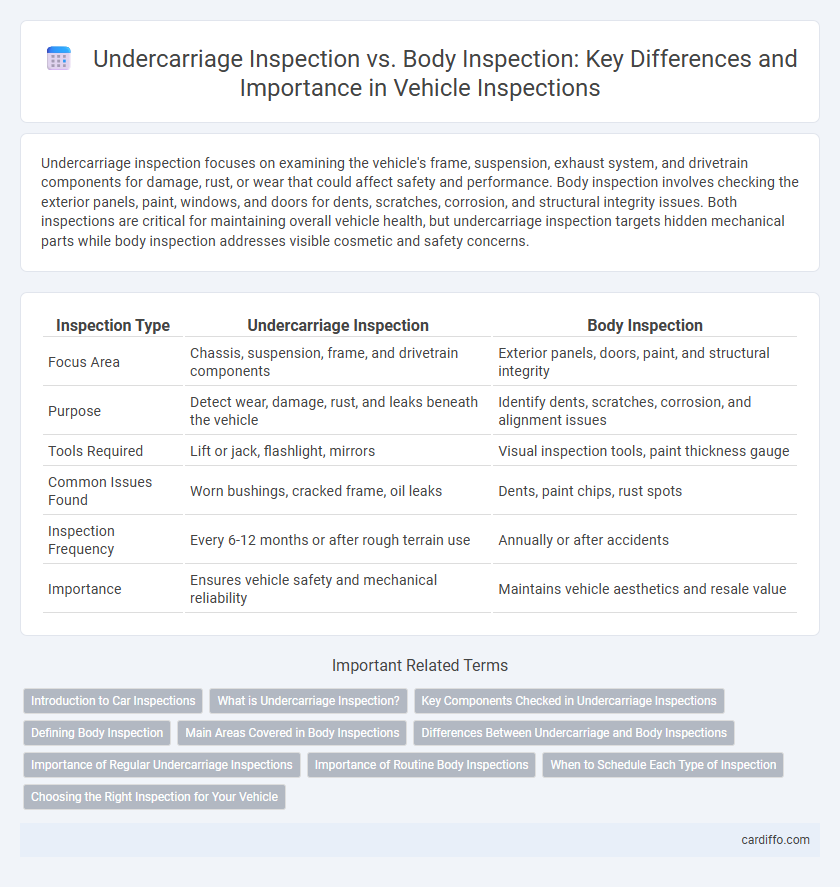Undercarriage inspection focuses on examining the vehicle's frame, suspension, exhaust system, and drivetrain components for damage, rust, or wear that could affect safety and performance. Body inspection involves checking the exterior panels, paint, windows, and doors for dents, scratches, corrosion, and structural integrity issues. Both inspections are critical for maintaining overall vehicle health, but undercarriage inspection targets hidden mechanical parts while body inspection addresses visible cosmetic and safety concerns.
Table of Comparison
| Inspection Type | Undercarriage Inspection | Body Inspection |
|---|---|---|
| Focus Area | Chassis, suspension, frame, and drivetrain components | Exterior panels, doors, paint, and structural integrity |
| Purpose | Detect wear, damage, rust, and leaks beneath the vehicle | Identify dents, scratches, corrosion, and alignment issues |
| Tools Required | Lift or jack, flashlight, mirrors | Visual inspection tools, paint thickness gauge |
| Common Issues Found | Worn bushings, cracked frame, oil leaks | Dents, paint chips, rust spots |
| Inspection Frequency | Every 6-12 months or after rough terrain use | Annually or after accidents |
| Importance | Ensures vehicle safety and mechanical reliability | Maintains vehicle aesthetics and resale value |
Introduction to Car Inspections
Car inspections encompass various crucial assessments, including undercarriage inspection and body inspection, each targeting specific vehicle components to ensure safety and functionality. Undercarriage inspections focus on examining the vehicle's frame, suspension, brakes, exhaust system, and drivetrain for signs of damage, corrosion, or wear that can affect structural integrity and performance. Body inspections evaluate the exterior panels, paint, windows, and seals for dents, rust, alignment issues, and potential damage that might compromise aesthetics and weather protection.
What is Undercarriage Inspection?
Undercarriage inspection involves a detailed examination of the vehicle's components beneath the chassis, including the suspension system, axles, brakes, and exhaust. This inspection detects wear, corrosion, damage, and potential mechanical issues that can affect safety and performance. Regular undercarriage inspections are critical for maintaining vehicle integrity, preventing costly repairs, and ensuring optimal functionality on various terrains.
Key Components Checked in Undercarriage Inspections
Undercarriage inspections focus on critical components such as tracks, rollers, sprockets, idlers, and hydraulic lines to ensure optimal performance and prevent costly breakdowns. These inspections identify wear, cracks, and leakage that can compromise machine stability and safety. In contrast, body inspections primarily address structural integrity, paint conditions, and external attachments, emphasizing overall vehicle appearance and exterior damage.
Defining Body Inspection
Body inspection involves a detailed examination of a vehicle's exterior and interior components to assess structural integrity, paint condition, and potential damage from corrosion or impacts. This process includes checking doors, windows, panels, and the frame for dents, rust, or misalignment that may affect safety and aesthetics. Unlike undercarriage inspection which targets the chassis and mechanical parts, body inspection emphasizes surface condition and visible defects.
Main Areas Covered in Body Inspections
Body inspections primarily focus on key areas such as the vehicle's frame, panels, doors, windows, and paintwork to identify dents, scratches, corrosion, or structural damage. Inspectors also evaluate seals, weather stripping, and alignment of body components to ensure proper function and prevent water leaks or wind noise. This thorough assessment helps maintain vehicle aesthetics, safety, and resale value by addressing visible and hidden body issues promptly.
Differences Between Undercarriage and Body Inspections
Undercarriage inspection primarily involves checking the vehicle's suspension, brakes, exhaust system, and drivetrain components for wear, damage, or corrosion, while body inspection focuses on exterior panels, paint condition, dents, rust, and structural integrity. The undercarriage requires inspection techniques such as lifting the vehicle and using mirrors or cameras to access hidden parts, whereas body inspection is typically visual and tactile for surface irregularities and damage. Differences in inspection scope ensure comprehensive vehicle safety and maintenance, addressing mechanical function beneath the vehicle versus aesthetic and protective elements on the exterior body.
Importance of Regular Undercarriage Inspections
Regular undercarriage inspections are crucial for maintaining vehicle safety and performance by identifying issues such as rust, loose components, or damage that can compromise structural integrity. Unlike body inspections that focus on cosmetic or external damage, undercarriage checks target hidden wear and tear affecting suspension, brake lines, and exhaust systems. Timely detection and repair during these inspections prevent costly repairs and extend vehicle lifespan.
Importance of Routine Body Inspections
Routine body inspections are essential for identifying corrosion, dents, and structural damage that can compromise vehicle safety and appearance. Consistent checks help detect early signs of wear, preventing costly repairs and ensuring compliance with safety regulations. Prioritizing body inspections maintains vehicle integrity and prolongs its service life, complementing undercarriage inspections that focus on chassis and suspension components.
When to Schedule Each Type of Inspection
Schedule undercarriage inspections primarily after operating in rough terrain, muddy conditions, or following heavy use that may cause wear or damage to tracks, rollers, and suspension components. Body inspections should be conducted regularly during routine maintenance or after any incidents that involve impacts, scratches, or corrosion risk to ensure structural integrity and cosmetic upkeep. Timely scheduling of each inspection type prevents costly repairs and extends equipment lifespan by addressing specific wear patterns and damage early.
Choosing the Right Inspection for Your Vehicle
Undercarriage inspection targets critical components such as suspension, exhaust, and brake systems that impact safety and performance, while body inspection evaluates exterior damage, corrosion, and paint condition to maintain aesthetics and structural integrity. Selecting the right inspection depends on your vehicle's usage: off-road or rough terrain vehicles benefit from thorough undercarriage checks, whereas daily drivers exposed to urban hazards require frequent body inspections. Prioritize undercarriage inspections for mechanical reliability and body inspections for cosmetic upkeep to ensure comprehensive vehicle maintenance.
Undercarriage Inspection vs Body Inspection Infographic

 cardiffo.com
cardiffo.com